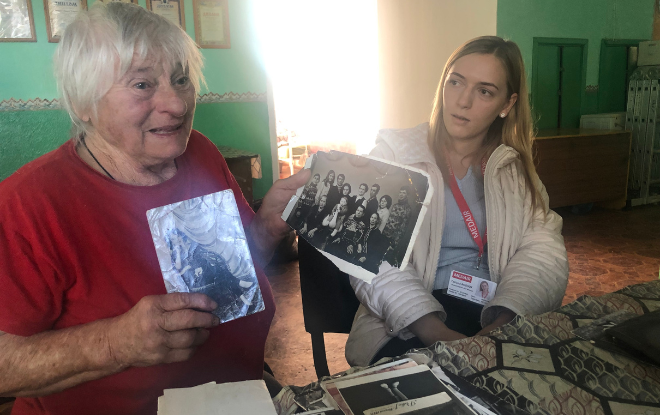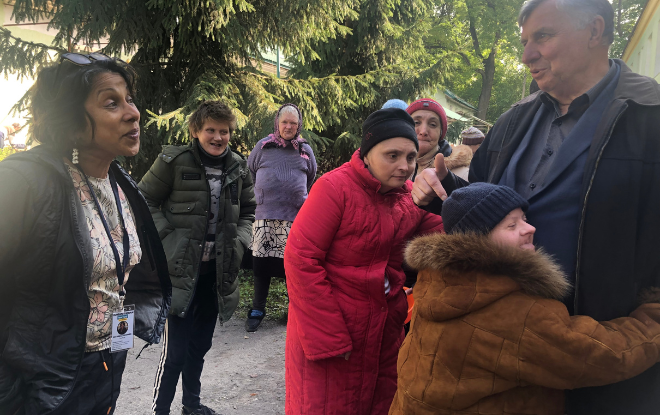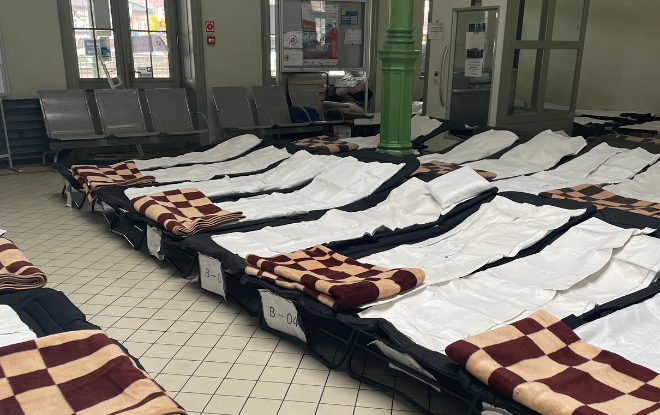A journey through war-torn Ukraine
8739 0
We enter Ukraine through one of the land border crossings at Medyka, Poland. It is a slightly surreal experience to wheel one’s rickety suitcase along a pot-holed path, past the white canvas tents set up by UNICEF and others, past the overflowing portable toilet, through the Soviet-era immigration building with its turnstiles and mustardy flooring, and onto the street outside. On both sides of the border, trucks and other vehicles queue for days. Signs are in indecipherable Cyrillic script. We are helpless and mute until our cheerful driver Vitali finds us.
To move through a country in the grip of a humanitarian crisis is to be aware of every inflection in the voices around you. The shivering of atoms that might indicate the launch of a Russian missile from thousands of miles away. The location of the nearest underground bunker with ventilation and stores of water. The reliance on a network of helping hands.
The NGO staff equip us with a decontamination pack each. Iodine tablets to counteract radioactive iodine (produced post-nuclear explosion, absorbed by our thyroids, causative of cancer), levonorgestrel tablets to prevent pregnancy in the event of a sexual assault, a single-use gas mask with insectoid eyes and a blunt snout, a large bottle of water to clean our skin of toxic chemicals or biological agents, saline rinses for our eyes.
I haven’t exactly told my parents where I am.
Ukraine is an ancient land threaded with the memory of Cossacks, poets and Slavic kings, a varied history of invasion and counter-attack. There is no coherent narrative that validates this current invasion. The killing of civilians and deliberate targeting of civilian infrastructure undeniably constitute war crimes.
Olena, the director of an arts institute in Ternopil who is helping to house 170 displaced Ukrainians with the NGO’s help, says, "I was 22 when Ukraine gained independence in 1991. Until then, I felt I was being watched all the time. I remember my parents speaking in whispers in the kitchen. Since independence, I have enjoyed being able to vote and speaking my mind."
The landscape is enormous, and apart from the rumple of the Carpathians to the west and the Crimean mountain range to the south, it is largely flat steppes. The soil is old, smooth-skinned, worn down by erosion, unlike Aotearoa with her curves and dimples and fat-fleshed mountains. Ukrainian roads run straight as grey needles. Vitali is a courteous, safe driver. There are Ladas, a relic from a Soviet past; but there are also Peugeots, Audis, BMWs. A high-speed convoy with an unmarked truck whizzes past us, carrying weapons to the front line. There are shiny gold-domed Eastern orthodox churches. We pass field after field nodding with blackened sunflower heads. Sunflower oil is a major export. I ask why the seeds have not been harvested; these heads look damp and rotted to me. Most of the processing plants are in the east, our guide tells us, and either damaged by missile strikes or shut. Millions of hryvnia wasted.

Baba Halia, who lost her son and daughter-in-law to the Russians, shares photos of her family.
It is autumn, that season of mists and mellow fruitfulness, coming after one of the hottest summers in Europe’s memory. Trees the colour of burnt butter, candied orange, blood red fringe the highway. There is fog, cool and mysterious. The soil is rudely fertile: Ukrainian black earth, or chernozem, is loamy and rich in humus. Branches groan with apples and pears. Grapevines slither along fences, the fruit purplish-sweet and winey. Earlier this year, there were apricots and plums. The Ukrainian flag, with its clear stripes of yellow and blue denoting fields of wheat under the wide East European sky, is testament to this fecundity.
Twenty-three internally displaced people, from a rest home in the Donetsk region, now live in an abandoned school in a small village outside Khmelnytsky. We step inside, and a sour smell hits us - floor cleaner, boiled cabbage, milk. A man hobbles past on the stumps of his knees. White-haired men and women wave at us from their beds, or stare vacantly into space. The bedrooms, flooded with sun, have new joinery installed by the NGO. The rooms are warm for now. But winter is coming; this village will be snowed in, the roads impassable. The caretaker is desperate for firewood. We speak with Baba Halia. She was born in 1940 - the same year as my father. Dressed in a rumpled red T-shirt, with short white hair and a weathered tinge to her cheeks, she pulls out her ‘treasures’ - photo after photo of her family. The theme from the X Files plays on a nearby TV. Baba Halia tells us that Russian soldiers burned her son to death, drowned her daughter-in-law, raped her 14-year-old grand-daughter. Tetiana, who is helping to translate, cannot speak for several minutes.
Another building nearby - previously a tuberculosis sanatorium - houses 96 displaced people with intellectual disabilities. The group were transported here in March to escape the bombing of Kharkiv. The oldest is 70. Another tremendously vulnerable group. The red linoleum is cracked underfoot. Antique metal bed frames wobble and need replacing. The toilets are a corrupt mess of rust and broken stone. By contrast, the toilets and showers the NGO have refurbished gleam with new boilers, pipes and tiles. Local villagers staff the building day and night, and they’ve stockpiled enough wood and coal for winter.

A refuge centre for internally displaced people with intellectual disabilities.
When we visit the Soviet-era building that Olena runs in Ternopil, we find similar issues - cracked cisterns, ancient stoves, leaking pipes. All over Ukraine, there is a similar theme to the aid efforts, namely helping uninhabited or run-down buildings become safe for the sudden influx of people. So far, the NGO has helped refurbish bathrooms and the sewer system, and provided new boilers, washing machines, umpteen mattresses. Olena says, "Fear is contagious. Like Covid. Each person reacts differently to war. Helping others helps me to cope." A hundred and seventy people, 56 of whom are children, live here. There is capacity for another 120. Vika, a shy 13-year-old clutching a tiny rabbit knitted by her mum, shares a room with her grandma Ludmyla. They’ve been here since April 28. Vika’s blue eyes brim with tears as Ludmyla tells us that Vika’s parents stayed behind in Kharkiv because her mum is a nurse. The teenager has dreams of becoming a vet, and the only time she smiles is when we show her a photo of our Huntaway cross.
We head back to Poland to catch up with the NGO’s work assisting refugees. We board the train at Ternopil alongside fleeing Ukrainians. The train is completely full. Suitcases cram the aisles. Children wail. I imagine it was even more chaotic in March and April. Ukrainian soldiers check our identities; they are amazed to meet New Zealanders. One carriage is filled with Hasidic Jews in traditional dress; this sub-group of conservative Judaism arose in Ukraine in the 18th Century. There is a fizzing release of tension as the train crosses the border after almost six hours. The queue is long and snakes into the night as Polish customs officers briskly check our papers.
The next few days, we visit a disused Tesco supermarket building in Przemyśl that has been converted into temporary refugee accommodation. Five thousand refugees camped here at the peak of the influx; currently there are 137, but more may come flooding in as winter bites. The space is cavernous, with the echoey feel of a warehouse. A few kids tear around the play area kicking a ball. Multiple aid agencies work from this site, providing counselling, food, clothing, travel assistance, cash. At the nearby train station, Tearfund’s partner NGO has helped set up a room as a safe transit space for mothers and babies. There are 50 beds here.

Beds set up for refugees in a train station.
I see displaced Roma families outside the train station. A plethora of small kids chirrup and fight. They’ve been told they can’t come inside. My brown skin and dark hair has seen me stopped by customs officials more than my two fellow travellers. It’s a sad reminder that the whiteness of your skin can lead to better outcomes in many circumstances.
The UN refugee agency and the International Organisation for Migration estimate 7.5 million Ukrainian refugees have fled the country. Within Ukraine, there were 6.9 million people who were internally displaced at one point; this number is in constant flux. This is the largest human displacement crisis in the world today. Many refugees go back to their homes for short stints when it’s relatively safe, before leaving again. This criss-crossing is constant. It’s unusual; in other parts of the world, once a refugee returns to their place of origin, they cannot claim refugee status anymore. It’s hard for aid organisations to plan ahead for winter. Will people try to stick it out, will gas supplies and heating be cut to cities, how many other objects of civilian infrastructure will be targeted?
For now, Tearfund’s partner and other aid organisations are preparing for the worst.